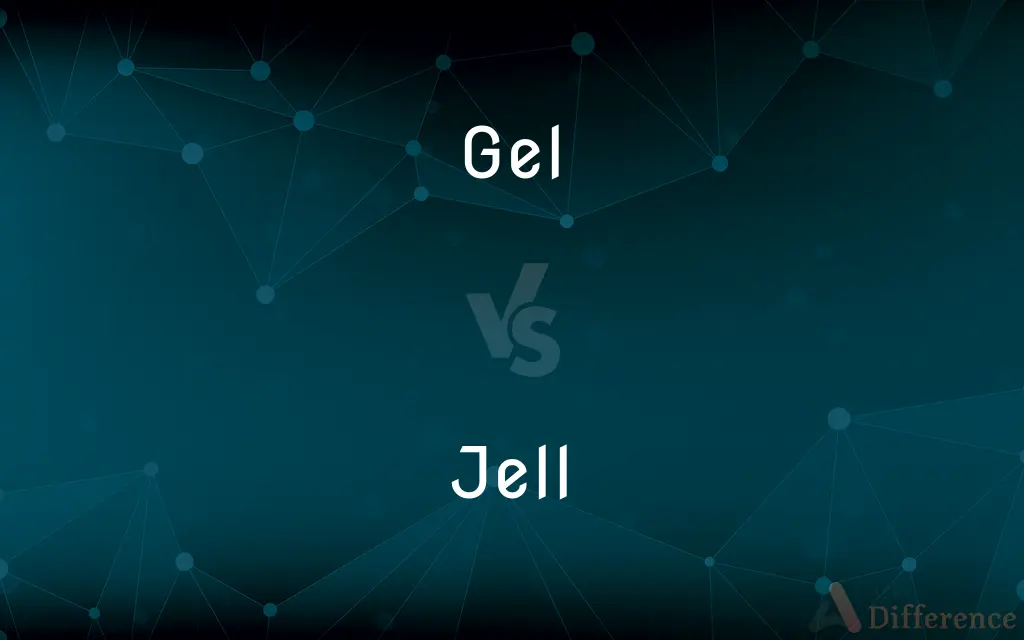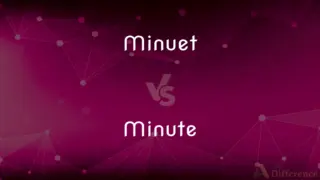Gel vs. Jell — What's the Difference?
By Tayyaba Rehman & Urooj Arif — Updated on March 17, 2024
Gel is a semi-solid substance that is jelly-like and often used in cosmetics and food products, whereas jell refers to the process of becoming firm or setting into a gel-like consistency.

Difference Between Gel and Jell
Table of Contents
ADVERTISEMENT
Key Differences
Gel is a versatile substance that exists in a semi-solid state, possessing both liquid and solid properties. It's commonly found in a wide range of products, from hair styling products to food items, due to its unique texture and ability to hold components together. Jell, on the other hand, is a verb that describes the process by which a liquid mixture transforms into a gel-like state. This term is often used in cooking and chemistry to indicate the transition from a fluid to a more solid, cohesive form.
The physical properties of a gel make it ideal for various applications, including medical, cosmetic, and culinary uses. Its jelly-like consistency allows for easy application and adherence to surfaces, making it a preferred choice for topical medications and skincare products. Jell signifies the action leading to this consistency, a critical step in recipes for jams, jellies, and certain desserts, as well as in the creation of gel-based products.
When discussing their usage in everyday language, "gel" is often used as both a noun and a verb (to gel), implying the formation of a cohesive, unified substance or idea. In contrast, "jell" specifically focuses on the process of setting or solidifying, with a somewhat narrower scope of use. While "to gel" might refer to ideas or plans coming together effectively, "to jell" typically refers to the physical process of becoming more solid or structured.
In the culinary world, the distinction becomes clearer. Gelatin, for example, is a substance derived from collagen used to create gels in cooking and baking. The process of cooling a liquid containing gelatin to form a dessert, like jelly, is referred to as "jelling." This distinction underscores the practical difference between the end product (gel) and the process (jell) leading to its formation.
Despite their differences, the terms "gel" and "jell" are sometimes used interchangeably in casual conversation, particularly in contexts where the distinction between the process and the product is blurred. However, in professional and technical settings, understanding and using the correct term is important for clarity and accuracy.
ADVERTISEMENT
Comparison Chart
Definition
A semi-solid, jelly-like substance used in various products.
The process of transforming from a liquid to a gel-like state.
Usage
As a noun (the substance) and verb (to become cohesive).
Primarily as a verb (the act of setting or solidifying).
Applications
In cosmetics, food, pharmaceuticals, and more.
In cooking, chemistry, and product formulation.
Example Context
Gel used in hair styling products or edible gels.
Jell as in the process of making jam or jelly setting.
Language
Can imply both the physical substance and the act of forming a cohesive or unified whole.
Specifically refers to the physical process of setting or solidifying.
Compare with Definitions
Gel
Can be derived from natural or synthetic sources.
The natural fruit gel was made from pectin.
Jell
Indicates the setting process of substances.
Wait for the sauce to jell before serving.
Gel
A substance with a consistency between solid and liquid.
The aloe vera gel soothed her sunburned skin.
Jell
Can refer to the clarification or solidification of ideas or plans.
The team's strategy began to jell after the meeting.
Gel
Used in various industries for its unique properties.
The culinary gel added a unique texture to the dessert.
Jell
Describes a critical phase in the formation of a gel-like structure.
The gelatin needs to jell to form the dessert properly.
Gel
Versatile in its application and formulation.
The gel medication was easier to apply than creams.
Jell
To become semi-solid, especially when cooling.
The jelly began to jell as it cooled in the refrigerator.
Gel
Often clear or translucent.
She applied the clear eyebrow gel to tame her brows.
Jell
Used in the context of cooking or chemical processes.
The mixture will start to jell after a few minutes of stirring.
Gel
A gel is a semi-solid that can have properties ranging from soft and weak to hard and tough. Gels are defined as a substantially dilute cross-linked system, which exhibits no flow when in the steady-state.
Jell
(of a liquid or semi-liquid substance) set or become more solid
She works at it all day but can't get the jelly to jell
Chicken or fish stock will jell when chilled
Gel
A a thick, clear, slightly sticky substance, especially one used in cosmetic or medicinal products
Hair gel
Jell
(of a project or idea) take a definite form or begin to work well
He decided to do a different film that would jell at the box office
Gel
A semi-rigid slab or cylinder of an organic polymer used as a medium for the separation of macromolecules.
Jell
To become firm or gelatinous; congeal.
Gel
An upper-class or well-bred girl or young woman
Fastidiously reared Home Counties gels
Jell
To take shape or become clear; crystallize
A plan of action finally jelled in my mind.
Gel
(of a liquid or semi-liquid substance) set or become more solid
The stew is gelling
Jell
To cause to become firm or gelatinous
Used pectin to jell the jam.
Gel
(of a project or idea) take a definite form or begin to work well
Everything seemed to gel for the magazine
Jell
To cause to take shape; make clear and definite; crystallize.
Gel
Apply gel to (the hair)
Short gelled hair
They'd gelled their hair
Jell
A jelly or gel
Gel
A colloid in which the disperse phase has combined with the dispersion medium to produce a semisolid material, such as a jelly.
Jell
To gel
Gel
See gelatin.
Jell
To jelly.
Gel
A jellylike substance used in styling hair.
Jell
To take on a more concrete or substantial form; - of ideas, plans, programs, etc.
Gel
To become a gel.
Jell
Become gelatinous;
The liquid jelled after we added the enzyme
Gel
To apply a gel to (the hair).
Gel
To take shape or become clear
Plans for the project are finally starting to gel.
Gel
A semi-solid to almost solid colloid of a solid and a liquid, such as jelly, cheese or opal.
Gel
Any gel intended for a particular cosmetic use, such as for styling the hair.
Gel
A girl.
Gel
(transitive) To apply (cosmetic) gel to (the hair, etc).
Gel
(intransitive) To become a gel.
Gel
(intransitive) To develop a rapport.
He was a nice guy, and I got on OK with his friends, but the two of us never really gelled.
Gel
To come together to form something; to cohere.
We put our ideas together and they eventually gelled into a saleable product.
Gel
A colloid in a more solid form than a sol
Gel
A thin translucent membrane used over stage lights for color effects
Gel
Become a gel;
The solid, when heated, gelled
Gel
Apply a styling gel to;
She mousses her hair
Common Curiosities
Is gel always used for hair styling?
While commonly used in hair styling, gel also has applications in food, cosmetics, and pharmaceuticals.
How does jell differ from gel?
Jell refers to the process of becoming gel-like, while gel is the substance itself.
Can all liquids jell?
Not all liquids can jell; the process typically requires specific conditions or ingredients, like pectin or gelatin.
How long does it take for a substance to jell?
The time varies depending on the substance and conditions but generally requires a period of cooling or setting.
Do gel products require refrigeration?
Some gel products, especially in food and certain cosmetics, may require refrigeration to maintain their structure.
Are there vegan alternatives to gelatin for making a gel?
Yes, agar-agar and pectin are popular vegan alternatives to gelatin for making gels.
Can ideas or strategies jell?
Yes, metaphorically, ideas or strategies can jell, meaning they become more developed and coherent.
What is gel made of?
Gel is made of a network of polymers that trap liquid, creating a jelly-like substance that can be natural or synthetic.
Are gel and jell interchangeable in cooking?
In cooking, gel often refers to the end product, while jell refers to the process of setting.
Can jell be used in a scientific context?
Yes, jell is used in scientific contexts to describe the setting process of materials.
What does it mean when a plan starts to jell?
It means the plan is beginning to take a clear, more structured form, becoming more cohesive.
What is the difference between gel and jelly?
Gel is a broad category of semi-solid substances, while jelly specifically refers to a clear or translucent fruit-based spread or dessert that has jelled.
How do you know when a mixture has jelled?
A mixture has jelled when it has thickened and holds its shape when moved or tilted.
Is gelatin necessary for jelling?
Gelatin is a common agent for jelling in cooking, but other substances like agar-agar can also be used.
Can the term jell be used in everyday language?
Yes, jell can be used in everyday language to describe processes, ideas, or plans becoming more defined or structured.
Share Your Discovery

Previous Comparison
Minuet vs. Minute
Next Comparison
Palpable vs. PalatableAuthor Spotlight
Written by
Tayyaba RehmanTayyaba Rehman is a distinguished writer, currently serving as a primary contributor to askdifference.com. As a researcher in semantics and etymology, Tayyaba's passion for the complexity of languages and their distinctions has found a perfect home on the platform. Tayyaba delves into the intricacies of language, distinguishing between commonly confused words and phrases, thereby providing clarity for readers worldwide.
Co-written by
Urooj ArifUrooj is a skilled content writer at Ask Difference, known for her exceptional ability to simplify complex topics into engaging and informative content. With a passion for research and a flair for clear, concise writing, she consistently delivers articles that resonate with our diverse audience.
















































